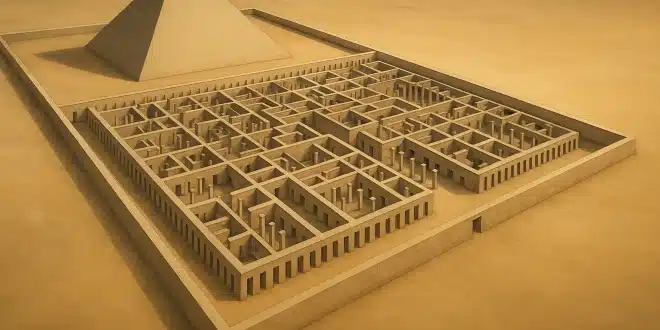Researchers have renewed interest in an ancient Egyptian site that may conceal a vast underground labyrinth beneath the Hawara pyramid. This pyramid, located south of Cairo, differs in appearance from the more iconic pyramids at Giza but has drawn attention for claims of a hidden structure composed of thousands of chambers and corridors beneath it.
Claims of a Hidden Underground Network
A 2023 publication titled The Labyrinth, The Colossi, And The Lake proposed that beneath the Hawara pyramid lies an expansive underground construction made up of roughly 3,000 interconnected rooms. The authors suggest that this structure, potentially pre-dating pharaonic Egypt, was the work of an advanced civilization whose identity remains unknown.
The idea of a labyrinth beneath the sand is not new. Historical accounts by Greek historian Herodotus, dating back over 2,500 years, described an enormous underground complex in the region that reportedly surpassed even the pyramids in splendor. According to Herodotus, during his visit around 500 BC, he was permitted to view the upper levels of the labyrinth but denied access to its lower, subterranean sections. He documented that the structure consisted of thousands of chambers distributed above and below ground.
Despite his accounts, modern archaeological studies have yet to confirm the existence of such a labyrinth. Conventional dating and excavation techniques have failed to yield clear evidence of the scale described by Herodotus. Still, recent advances in scanning technology have reopened the debate.
Modern Technology Rekindles the Search
Interest in the potential underground complex has grown due to newer tools like satellite imaging and ground-penetrating radar. These technologies have enabled researchers to analyze subsurface features without the need for intrusive digging. Preliminary scans in the region surrounding the Hawara pyramid have indicated unusual structural patterns beneath the surface, prompting further investigation.
The Hawara pyramid, constructed by Pharaoh Amenemhat III of the 12th Dynasty, is known for its unique megalithic architecture. It features three enormous stone blocks believed to have served as mechanisms to seal passageways — possibly ancient security measures. Though the pyramid is not as visually imposing as those at Giza, its internal structure hints at significant complexity.
In the late 19th century, British Egyptologist Sir Flinders Petrie uncovered portions of what he believed to be the labyrinth’s foundation. He documented large stone slabs and a grid-like configuration that matched descriptions from antiquity. However, Petrie was limited by the lack of modern excavation technology and water-related challenges in the area, leaving much of the potential site unexplored.
Cultural Significance and Ongoing Mysteries
The suggestion that the labyrinth was created by a highly organized civilization that may have existed prior to dynastic Egypt adds a provocative layer to the mystery. Some theories even suggest potential symbolic or cultural connections between the pyramid builders of Egypt and the creators of massive stone figures elsewhere, such as the Moai statues on Easter Island. While no direct evidence supports a link between the two cultures, both feature large, unexplained stone architecture that continues to puzzle historians and archaeologists.
There is also debate about the original function of the pyramids themselves. While many served as royal tombs, others may have had ceremonial, astronomical, or even protective purposes. The Hawara pyramid’s potential underground chambers add weight to the notion that these structures may have held functions beyond burial.
Over time, the suspected labyrinth is believed to have sunk beneath layers of sand, and parts may have been damaged or dismantled during invasions and centuries of environmental erosion. Yet, the possibility of what remains underneath continues to inspire archaeologists and independent researchers alike.
As investigations progress using non-invasive techniques, the true nature of what lies beneath the Hawara pyramid remains one of Egypt’s enduring archaeological enigmas — a mystery that could reshape the understanding of ancient history if ever fully uncovered.


